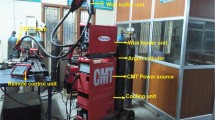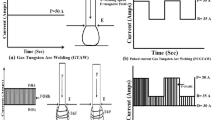Abstract
High strength aluminum alloys (Al-Zn-Mg-Cu alloys) have gathered wide acceptance in the fabrication of lightweight structures requiring high strength-to-weight ratio, such as transportable bridge girders, military vehicles, road tankers and railway transport systems. The preferred welding processes of high strength aluminum alloy are frequently the gas tungsten arc welding (GTAW) process and the gas metal arc welding (GMAW) process due to their comparatively easy applicability and better economy. Weld fusion zones typically exhibit coarse columnar grains because of the prevailing thermal conditions during weld metal solidification. This often results in inferior weld mechanical properties and poor resistance to hot cracking. In this investigation, an attempt has been made to refine the fusion zone grains by applying a pulsed current welding technique. Rolled plates of 6 mm thickness were used as the base material for preparing single pass welded joints. A single ‘V’ butt joint configuration was prepared for joining the plates. The filler metal used for joining the plates was AA 5356 (Al-5Mg (wt%)) grade aluminum alloy. Four different welding techniques were used to fabricate the joints: (1) continuous current GTAW (CCGTAW), (2) pulsed current GTAW (PCGTAW), (3) continuous current GMAW (CCGMAW) and (4) pulsed current GMAW (PCGMAW). Argon (99.99% pure) was used as the shielding gas. Tensile properties of the welded joints were evaluated by conducting tensile tests using a 100 kN electro-mechanical controlled universal testing machine. Current pulsing leads to relatively finer and more equi-axed grain structure in GTA and GMA welds. In contrast, conventional continuous current welding resulted in predominantly columnar grain structures. Grain refinement is accompanied by an increase in tensile strength and tensile ductility.
Similar content being viewed by others
References
Kim HT, Nam SW (1996) Solidification cracking susceptibility of high strength aluminum alloy weldment. Scr Mater 1139–1145
Janaki Ram GD, Mitra TK, Shankar V (2003) Microstructural refinement through inoculation of type 7020 Al-Zn-Mg alloy welds and its effect on hot cracking and tensile property. J Mater Process Technol 142:174–181
Madhusudhan Reddy G, Gokhale AA, Prasad Rao K (1998) Optimization of pulse frequency in pulsed current gas tungsten arc welding of aluminum-lithium alloy sheets. J Mater Sci Technol 14:61–66
Madhusudhan Reddy G, Sammaiah P, Murty CVS, Mohandas T (1999) Influence of welding techniques on microstructure and mechanical properties of AA 6061 (Al-Mg-Si) GTA welds. Proceedings of the international welding conference, New Delhi, India, pp 33-46
Prasad Rao K (2001) Recent trends in materials joining research. Proceedings of the national conference on recent advances in materials processing, Annamalai Nagar, India, pp 176-196
Mohandas T, Madhusudhan Reddy G (1996) Effect of frequency of pulsing in gas tungsten arc welding on the microstructure and mechanical properties of titanium alloy welds. J Mater Sci Lett 15:626–628
Shelwatker DA, Madhusudhan Reddy G, Gokhale AA (2002) Gas tungsten arc welding studies on similar and dissimilar combinations of Al-Zn-Mg alloy RDE 40 and Al-Li alloy 1441. Sci Technol Weld Join 352–361
Ghosh PK, Sharma V (1991) Chemical composition and microstructure in pulsed MIG welded Al-Zn-Mg alloy. J Mater Trans 32:145–150
Potluri NB, Ghosh PK, Gupta PC, Reddy YS (1996) Studies on weld metal characteristics and their influences on tensile and fatigue properties of pulsed current GMA welded Al-Zn-Mg alloy. Weld Res Suppl 62s–70s
Wang XG, Lin DC, Srivatsan TS (2003) Mechanism for the formation of equiaxed grains in welds of aluminum-lithium alloy 2090. Mater Sci Eng A 304–309
Shinoda T, Ueno Y, Masumoto I (1990) Effect of pulsed welding current on solidification cracking in austenitic stainless steel welds. Trans Jpn Weld Soc 21:18–23
Lin DC, Wang TS, Srivatsan TS (2003) A mechanism for the formation of equiaxed grains of aluminum-lithium alloy 2090. Mater Sci Eng A 335:304–309
Kou S, Le Y (1986) Nucleation mechanism and grain refining of weld metal. Weld J 65–70
Author information
Authors and Affiliations
Corresponding author
Rights and permissions
About this article
Cite this article
Balasubramanian, V., Ravisankar, V. & Madhusudhan Reddy, G. Effect of pulsed current welding on mechanical properties of high strength aluminum alloy. Int J Adv Manuf Technol 36, 254–262 (2008). https://doi.org/10.1007/s00170-006-0848-0
Received:
Accepted:
Published:
Issue Date:
DOI: https://doi.org/10.1007/s00170-006-0848-0




